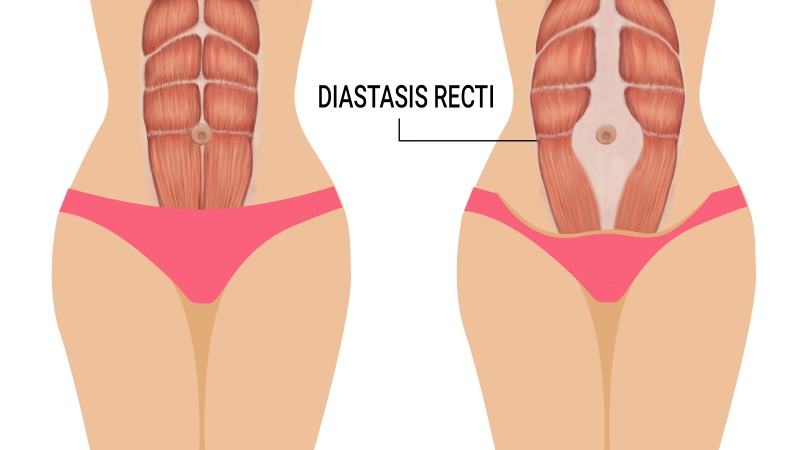
Diastasis Recti is commonly defined as a gap between the two sides of the rectus abdominis muscle. The gap can is about 2.7 cm or can be greater than that. It is also known as abdominal separation. The condition is not associated with any morbidity or mortality. Get physiotherapy treatment at home by experienced Dr. Rajesh Pal a well known physiotherapists who gives the best Diastasis Recti treatment in Gurgaon.
A majority of the victims of Diastasis Recti are newborns and pregnant women. It is also known to occur in men but to a much lesser extent. In pregnant or postpartum women, the cause of the condition is generally the stretching of the rectus abdominis by the growing uterus. Due to repeated episodes of stretching, the condition is more common in multiparous women. When the defect occurs during pregnancy, the uterus can often be spotted bulging through the abdominal wall under the skin. Apart from that, women, in general, are more vulnerable to develop Diastasis Recti as they hit the age of 35. Excessive abdominal exercises after the first trimester of pregnancy are also one of the culprits.
In the newborn babies, the rectus abdominis is not developed completely and may not be sealed together at midline. The condition is more common among premature and black newborns.
The most common cause of Diastasis Recti is the exertion of extreme pressure on your abdominal muscles as this causes them to stretch and separate. The separation in the muscles lets the intestines push through the muscles resulting in a bulge.
The other causes of the condition are -
The most common symptom of Diastasis Recti is a bulge in your stomach. The bulge becomes more prominent and noticeable as you strain or contract your abdominal muscles, such as when you sit up. In addition to the stomach bulge, the other symptoms of the disorder are -
A simple physical examination can diagnose Diastasis Recti with ease. It generally includes include measuring the distance between the rectus abdominis muscles at rest and during contraction at several levels along the lineaalba.
The doctor will usually instruct you to lie flat on your back followed by performing a half sit up, or a crunch in certain cases, as per the doctor's discretion. In the patients of Diastasis Recti, a vertical bulge will clearly be seen between the abdominal muscles.
The doctor can measure the gap between the muscles to determine the severity of the condition. Various methods like a pair of calipers, CT scan or even an ultrasound may be employed to measure this gap accurately. In case this is not sufficient, medical imaging may be performed by the doctor. It is almost mandatory in uncertain cases.
Another procedure used in the diagnosis is abdominal ultrasonography. It is a validated and repeatable alternative which holds the potential of confirming the diagnosis with a high degree of accuracy. In certain cases, it may detect hernias as a differential diagnosis. An abdominal CT scan is a better alternative to such scenarios.
Talking about the treatment for Diastasis Recti in Gurgaon, a lot of options are available at the patient's disposal. Physiotherapy has increasingly been proposed as one of the primary approaches towards treatment. You should work with your therapist to determine which treatment is right for you, based on the intensity of your symptoms. The Physiotherapy treatment found to be beneficial are K-Taping, and Transverses Abdominis muscle strengthening.
As the condition doesn’t cause any major health issues and is more of a cosmetic issue, some people choose to live with it and do absolutely nothing about it! Apart from that, no specialized treatment is necessary for women while they are still pregnant.
Physical exercises may help treat Diastasis Recti considerably. Consult your doctor or therapist about exercises that are safe for you to do as per your symptoms. You are more likely to be recommended exercises that strengthening your abdomen, back, and hips. Some other recommended exercises are core contraction, seated squeeze, head lift, upright push-up and squat against the wall. It must be noted that all the corrective exercises should be in the form of pulling in of the abdominal muscles. None of the exercises should be about pushing of the abdominal exercises outwards.
Core-strengthening routines such as Pilates or Yoga have also been found effective for the patients. It is crucial, however, that you do your exercises correctly and under the supervision of a therapist. Exercises such as powerlifting can even make the condition worse if you do them incorrectly or without expert supervision. Carefully learn the technique and work with a qualified physical therapist to learn the suitable way to perform any core-strengthening exercises. Using a belt to stabilize your core may also help you.
